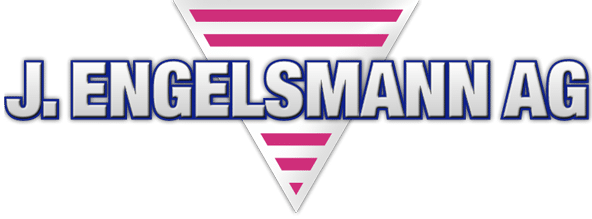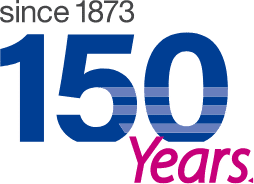Fertilizers based on urea have good free-flowing properties, but are very abrasive. This places the highest demands on the screening technology used in their production.
How economical machine use at the highest productivity level can still be achieved with a JEL Freischwinger tailored to the product-specific requirements – find out more here.
Plants need the right location, sun, water and fertilizer for healthy growth. The main components of mineral plant fertilizers are nitrogen, phosphorus and potassium. In addition, there are other minerals and trace elements. Urea fertilizer contains 46% pure nitrogen and is one of the most important nitrogen fertilizers in the world.
Urea (lat. Urea) is a white, crystalline solid with a faint ammonia odor – non-toxic and hygienically harmless. It has a high water-binding capacity, which is why it is used, among other things, as a moisturizing factor in cosmetics. Urea granules generally have good free-flowing properties and move easily over the mesh of the sieve inserts during sieving. However, due to its abrasive properties, it quickly attacks metallic surfaces and coatings. This must be consistently kept in mind in the design and the materials used.
For the classifying screening of the urea granules, the JEL Freischwinger vibrating screen was selected as the basis. And designed with individual adaptations for the screening of abrasive fertilizers.
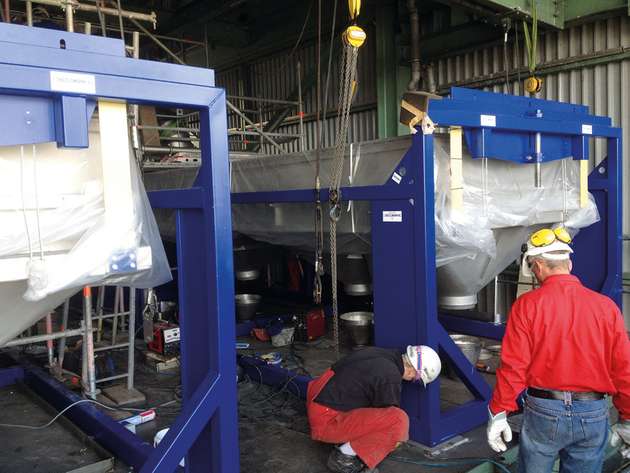
The two JEL Freischwinger are created: Im Doppelpack bilden sie eine Siebfläche von insgesamt 24 m² ab. And yet they are easy to handle and energy-efficient in operation.
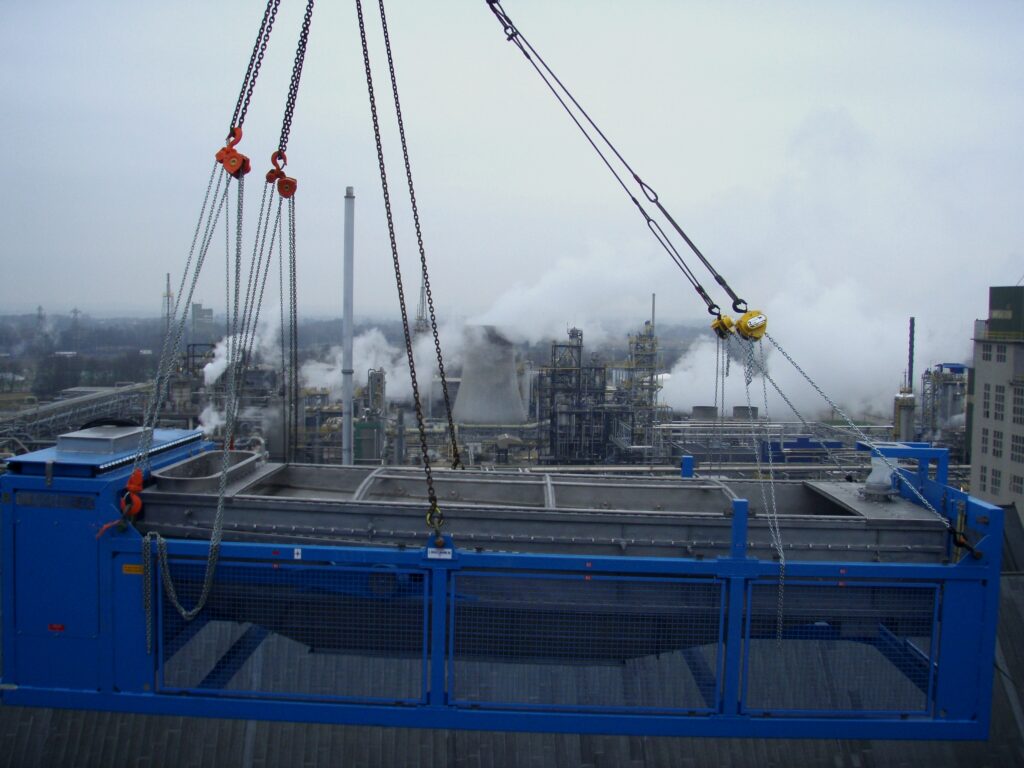
Hohe Durchsätze und doch produktschonend: Klassiersiebungen mit der JEL Freischwinger. Even the delivery required a delicate touch.
Gentle product classification | high material resistance | increased productivity
And economical in operation. Requirements that the screening technology used to date by another manufacturer no longer fully meets.
Due to the high product concentration of the nitrogen fertilizer, a separation efficiency of 98% was targeted. The customer specified a throughput capacity of 52 t/h per machine in order to achieve the planned increase in production. Other key factors for even greater productivity and economy in classifying screening were: easy machine handling, greater energy efficiency, shorter downtime for cleaning, and longer maintenance cycles.
The basic model of the JEL cantilever screening machine was designed for classifying screening in fertilizer production to the specified sizes: Two screening machines were planned, each in single-deck design with screen feeders arranged one behind the other. Each classifying screen covers a screening area of 12 m².
High separation efficiency of 99 % achieved. Re-screening is no longer necessary.
The screening machine is driven by an energy-efficient flywheel drive. The drive system sets the entire screening trough in horizontal oscillation via push rods so that optimum distribution of the urea granules on the screen cloth is achieved. A minimal vertical force component in the lifting movement prevents the particles from piling up on top of each other and causing the so-called “carpet formation”. The fine-grained urea granules always move flatly and with sufficient contact to the screen fabric along the length of the feeder and can be precisely classified.
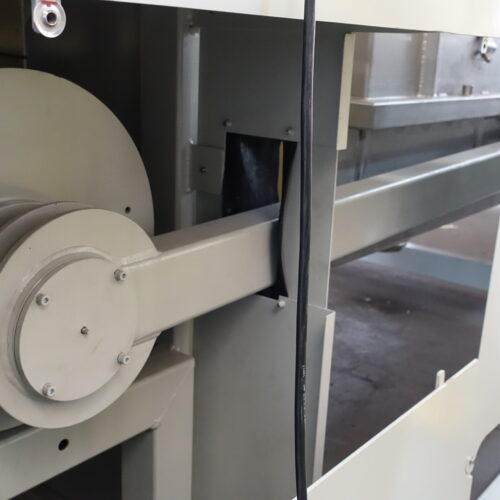
The flywheel drive sets the push rods and screening trough in a steady swinging motion. The flywheels store the kinetic energy and gradually release it again.
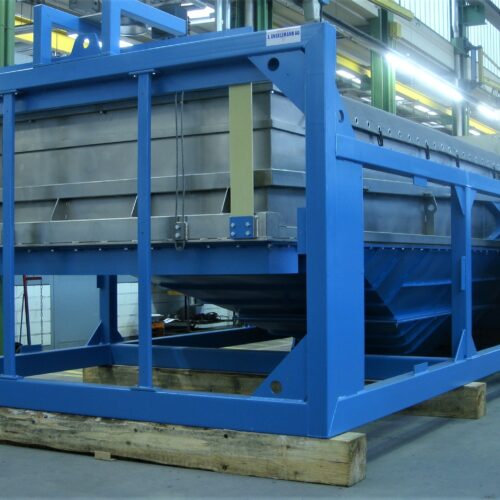
Once in motion, 10-20% of the rated current is sufficient for operation. The two 7.5 t heavyweights for fertilizer classification can thus be operated economically.
The vibrating screens are driven by a 5.5 KW electric motor. The power is transmitted by means of V-belts to a flywheel, which is connected to the screening trough via push rods. The lifting motion is precisely matched to the mass of the screening trough. The result is the low energy requirement of the drive system, based on the exact mass balance between the drive unit and the screening trough. The motor drives the flywheel mass for approx. 15 seconds at full rated current. Then 10 to 20 % of the rated current is sufficient to keep it in motion. In the process, the electrical energy is converted into rotational energy, stored in the flywheels and gradually released.
Product-friendly wear protection against abrasiveness, but how?
With well thought-out design features, easily replaceable wear protection devices and resistant materials, especially in the areas in contact with the product.
To minimize the abrasiveness emanating from the urea granules on the critical parts, the interiors of the two JEL Freischwinger are designed so that the granules spend only a short time on the screen deck.
Additional wear protection plates made of specially hardened materials are integrated at the critical deflection points of the screening machines. They prevent the delicate points from “shooting through” too quickly and significantly increase the service life of the machines.
The screen feeders are covered with hard-drawn fabric made of high-tensile stainless steel wire. Product distribution plates under the inlet ensure gentle material feeding into the screening machine. On the one hand, this prevents damage to the mesh. On the other hand, the granules are optimally distributed over the screen mesh. Both components can be easily replaced.
In order to ensure a screening process that is gentle on the product, all parts that come into contact with the product are made of pickled and passivated stainless steel (V4A 1.4571) without any transitions. A high proportion of smooth surfaces in the interior enables easy cleaning.
For precise separation efficiency and high throughput in continuous operation, a free sieve mesh is required
To prevent the meshes from becoming clogged with boundary or plug grain during the screening process, an additional screen cleaning system has been integrated in both machines.
Depending on the product, different cleaning systems are used in industrial screening machines. Solutions with triangular or ball cleaning and ultrasound are common. Ball cleaning is suitable for the classifying screening of urea granules.
The impact beads are made of abrasion-resistant silicone to prevent contamination of the granules. The inserts with the balls are located directly below the sieve trough. When the screen trough is moved, the balls hit the screen mesh from below. Particles that have become lodged in the screen mesh are loosened and conveyed back into the product stream. In this way, clogging of the screen feeders with plugged grain is permanently avoided, and the full screening capacity of both machines can be utilized.
The two JEL Freischwinger can each classify four fractions in one screening pass. Each individual fraction is discharged and discharged via a separate outlet:
The screened undersize is returned to the process for recycling purposes,
the fines pass to the granulator,
the good grain is filled as a product ready for sale, and
the oversize is also returned to the granulator via a crusher.
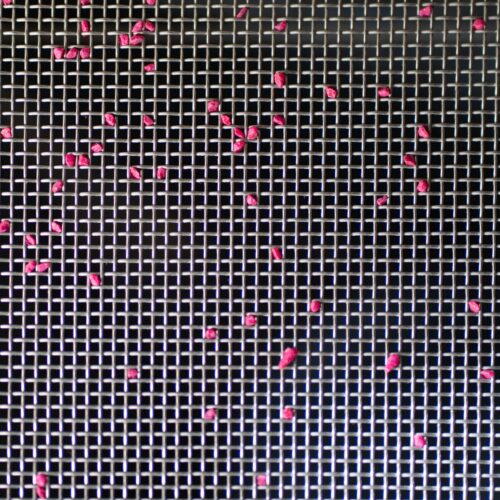
Avoid plugged grain!
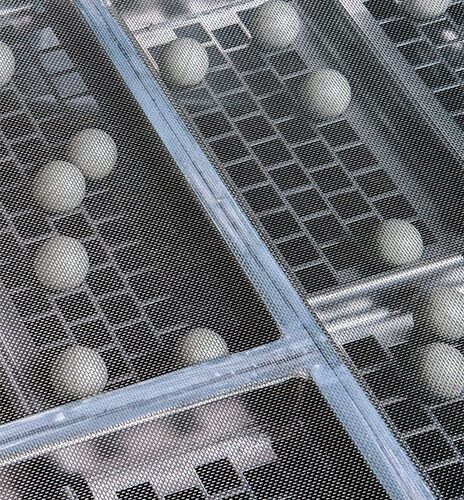
With 1a screen inserts and matching cleaning./strong>
Lower operating costs with higher machine availability
In order to keep downtimes to a minimum in three-shift operation 7 days a week, simple handling is also required for large screening machines. The screen feeder has to be changed quickly and the screening technology as a whole has to be low-maintenance.
Here the solution was pragmatic: Both JEL cantilever screens are equipped with a sturdy cover sheet. It covers the screen surface and is easier to handle than a metal cover or individual cover segments of the same dimension.
After removing the suspension lugs and opening the eccentric clamps, the screen inserts are easily accessible and quick to replace. The uncomplicated handling of the vibrating screens makes it possible to significantly reduce downtimes compared to the screening technology previously used, thus increasing machine availability.
Die Montage der beiden Schwingsiebmaschinen am Aufstellort konnte ohne zusätzliche Fundamentverstärkungen oder ähnliches erfolgen. The smoothly operating flywheel drive of the JEL Freischwinger transmits only minimal vibrations from the machine to the surroundings during operation. Auch die Laufgeräusche sind, mit Blick auf die Größe der Maschine, vergleichsweise gering.
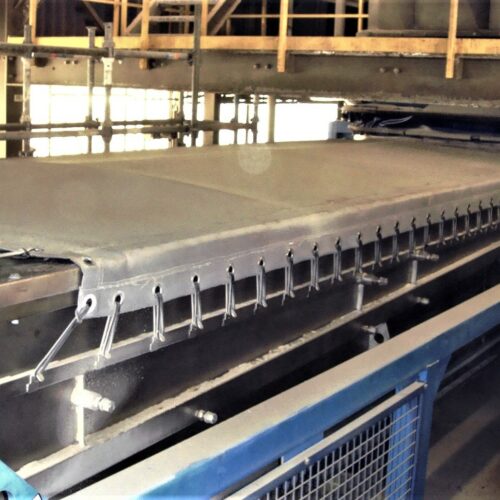
The robust cover protects the screenings from contamination. And it does not have to be removed with a crane when changing the screen feeder, like the cover on the replaced screener.
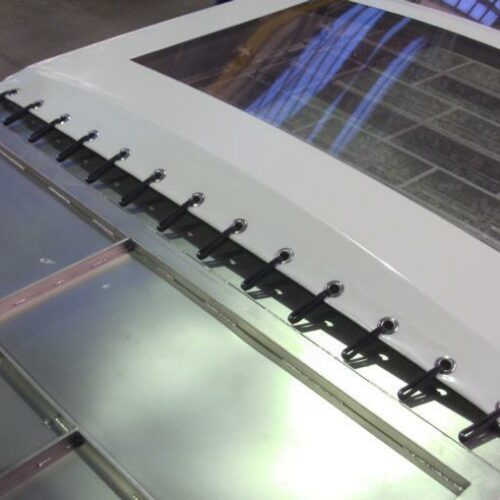
It doesn’t always have to have a lid on it: The JEL cantilever, with tarpaulin and viewing window. The important thing is that the solution fulfills its function.
Conclusion
It pays to replace aging screening equipment.
The two JEL Freischwinger from Engelsmann have paid off for the fertilizer producer in many ways.
Implementation of a classification screening of urea granules that is gentle on the product and provides high separation efficiency
Increase in throughput per square meter of screen area: same production capacity on half the screen area
Operating costs reduced thanks to energy-efficient flywheel drive: from 11 to 5.5 KW
Wear protection reduces repair and maintenance costs: fewer spare parts and longer maintenance cycles for even greater efficiency
Setup time down: Simplified machine handling saves an enormous amount of time. The lightweight cover can be quickly removed when changing the screen feeder.
No more crane: Until now, the heavy cover of the predecessor machine was lifted with the help of a crane for screen changes.
